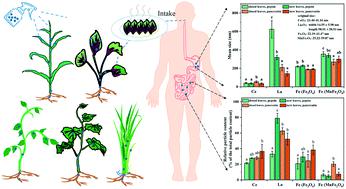当前位置:
X-MOL 学术
›
Environ. Sci.: Nano
›
论文详情
Our official English website, www.x-mol.net, welcomes your feedback! (Note: you will need to create a separate account there.)
Uptake and bioaccumulation of nanoparticles by five higher plants using single-particle-inductively coupled plasma-mass spectrometry
Environmental Science: Nano ( IF 7.3 ) Pub Date : 2022-07-20 , DOI: 10.1039/d1en01195b Jing Wang 1, 2 , Le Yue 1, 2 , Jian Zhao 3 , Xuesong Cao 1, 2 , Chuanxi Wang 1, 2 , Feiran Chen 1, 2 , Zhenggao Xiao 1, 2 , Yan Feng 1, 2 , Zhenyu Wang 1, 2
Environmental Science: Nano ( IF 7.3 ) Pub Date : 2022-07-20 , DOI: 10.1039/d1en01195b Jing Wang 1, 2 , Le Yue 1, 2 , Jian Zhao 3 , Xuesong Cao 1, 2 , Chuanxi Wang 1, 2 , Feiran Chen 1, 2 , Zhenggao Xiao 1, 2 , Yan Feng 1, 2 , Zhenyu Wang 1, 2
Affiliation

|
The exposure risk of nano-enabled products towards plants and related food safety has attracted great attention. Here, particle concentrations and the size distribution of nanoparticles (NPs) in five plants (rice, maize, cucumber, amaranth and kidney bean) after foliar exposure to CeO2, La2O3, Fe3O4, and MnFe2O4 NPs at a concentration of 10 mg L−1 were quantified by single-particle-inductively coupled plasma-mass spectrometry (SP-ICP-MS). All four NPs were taken up by the five plants. In the dosed leaves (application site) of the five plants, the mean sizes of Ce- and La-based NPs were 30–39 nm and 20–55 nm, respectively, close to their original sizes. The mean sizes of Fe-based NPs (Fe3O4 and MnFe2O4) were in the range of 170–185 nm and 119–166 nm, respectively, larger than their original sizes. After transport to the leaves and roots, Ce-, La- and Fe (MnFe2O4)-based NPs had smaller mean sizes than those in the dosed leaves, while Fe (Fe3O4)-based NPs had a larger size. The particle concentrations of Ce-, La- and Fe (Fe3O4)-based NPs in amaranth dosed leaves were higher than those in other plants, by up to 6 times, and the concentration of Fe (MnFe2O4)-based NPs (9.78 × 106 particles L−1) was the highest in kidney beans compared to the other plants. The quantification of NPs in amaranth leaves after in vitro-simulated gastro and gastrointestinal digestion further revealed that all four NPs were possibly accessible to the human system, ranging from 5–79%. This study provides significant guidance for the assessment of the bioaccumulation of NPs in plants and their environmental health risks.
中文翻译:

五种高等植物利用单粒子电感耦合等离子体质谱法对纳米粒子的吸收和生物积累
纳米产品对植物和相关食品安全的暴露风险引起了极大的关注。此处,在叶面暴露于 CeO 2、La 2 O 3、Fe 3 O 4和 MnFe 2 O 4后,五种植物(水稻、玉米、黄瓜、苋菜和芸豆)中的颗粒浓度和纳米颗粒 (NPs) 的尺寸分布浓度为 10 mg L -1的 NP通过单粒子电感耦合等离子体质谱(SP-ICP-MS)进行量化。所有四种 NP 都被五种植物吸收。在五种植物的给药叶片(应用部位)中,基于 Ce 和 La 的 NPs 的平均尺寸分别为 30-39 nm 和 20-55 nm,接近其原始尺寸。Fe 基纳米粒子(Fe 3 O 4和 MnFe 2 O 4)的平均尺寸分别在 170-185 nm 和 119-166 nm 的范围内,大于它们的原始尺寸。在输送到叶和根后,基于 Ce-、La-和 Fe (MnFe 2 O 4 ) 的 NPs 的平均尺寸小于投药叶中的平均尺寸,而 Fe (Fe 3 O 4) 基于 NP 的尺寸更大。苋菜叶中Ce-、La- 和 Fe (Fe 3 O 4 ) 基 NPs 的颗粒浓度比其他植物高 6 倍,Fe (MnFe 2 O 4 )-与其他植物相比,基于 NPs (9.78 × 10 6粒子 L -1 ) 在芸豆中最高。体外模拟胃和胃肠消化后苋菜叶中 NPs 的定量进一步表明,所有四种 NPs 都可能对人体系统可及,范围为 5-79%。该研究为评估植物中NPs的生物积累及其环境健康风险提供了重要指导。
更新日期:2022-07-20
中文翻译:

五种高等植物利用单粒子电感耦合等离子体质谱法对纳米粒子的吸收和生物积累
纳米产品对植物和相关食品安全的暴露风险引起了极大的关注。此处,在叶面暴露于 CeO 2、La 2 O 3、Fe 3 O 4和 MnFe 2 O 4后,五种植物(水稻、玉米、黄瓜、苋菜和芸豆)中的颗粒浓度和纳米颗粒 (NPs) 的尺寸分布浓度为 10 mg L -1的 NP通过单粒子电感耦合等离子体质谱(SP-ICP-MS)进行量化。所有四种 NP 都被五种植物吸收。在五种植物的给药叶片(应用部位)中,基于 Ce 和 La 的 NPs 的平均尺寸分别为 30-39 nm 和 20-55 nm,接近其原始尺寸。Fe 基纳米粒子(Fe 3 O 4和 MnFe 2 O 4)的平均尺寸分别在 170-185 nm 和 119-166 nm 的范围内,大于它们的原始尺寸。在输送到叶和根后,基于 Ce-、La-和 Fe (MnFe 2 O 4 ) 的 NPs 的平均尺寸小于投药叶中的平均尺寸,而 Fe (Fe 3 O 4) 基于 NP 的尺寸更大。苋菜叶中Ce-、La- 和 Fe (Fe 3 O 4 ) 基 NPs 的颗粒浓度比其他植物高 6 倍,Fe (MnFe 2 O 4 )-与其他植物相比,基于 NPs (9.78 × 10 6粒子 L -1 ) 在芸豆中最高。体外模拟胃和胃肠消化后苋菜叶中 NPs 的定量进一步表明,所有四种 NPs 都可能对人体系统可及,范围为 5-79%。该研究为评估植物中NPs的生物积累及其环境健康风险提供了重要指导。



























 京公网安备 11010802027423号
京公网安备 11010802027423号